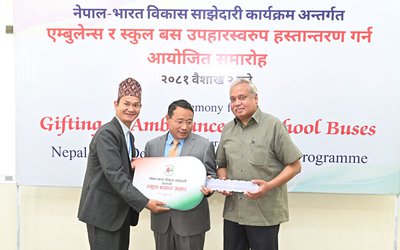It is important that the two basic issues raised by Upper Trishuli-3A (UT-3A) controversy should not be clubbed together. One is the morality issue of ‘len-then and chalkhel’ that the media extensively covered with a fine comb. The other is the technicality issue of 60 to 90 MW upgrading that has also been combed but more to suit one’s arguments only. Thus, the danger to mistake the trees for the forests is created in such a heated environment.
With the five NEA Unions[1] up in arms against the 90 MW upgrading and the gyapan patra to the Chairman of Interim Election Council by five former Ministers[2] fanning the controversy, the controversy took an ugly turn. The NEA unions armed themselves with the unlawful authority to disconnect the electricity supply of the Ministers at their Pulchowk quarters. For the rag-tag Interim Election government, this was the last straw on the camel’s back. The government buckled to its knees and ate the humble pie by retracting its 12-days old 90 MW decision back to 60 MW. The Energy Ministry Secretary[3] was made the lone scapegoat.
Basking in the immediate glow of hindsight, the writer enumerates below some of the cardinal sins in Upper Trishuli-3A’s 60 versus 90 MW controversies:
· Unwittingly, NEA committed the first cardinal sin by planting the ‘Alternative Proposals by Bidders’ seed in the February 2009 EPC Tender Documents. The 2009 August annual report of NEA mentions that the 2007 DPR of UT-3A envisaged it as a 60 MW, 460 GWh project at an estimated US$ 125 million cost with a US$ 120 million concessional loan from China. Why NEA asked for this alternative proposal could be an interesting debate in itself. If NEA had not committed this sin, it is likely the 60 MW UT-3A would have been commissioned by now. Of the four bidders, only China Gezhouba Group Company (CGGC) offered the alternative proposal.
· CGGC committed the second cardinal sin. The contractor quoted US$ 111.00 million for the 60 MW and as requested by the tender document offered the 90 MW option for an‘additional 25% cost’. Media reports that, CGGC finding that its competitor, Sino Hydro, had bid US$ 90 million for 60 MW, offered, on the last tender submission day, a discount so that its bid price for 60 MW became US$ 89.1179 million. Thus, whether the ‘additional 25% cost’ for the 90 MW option was on US$ 89.1179 million or US$ 111.00 million became a moot point.
· NEA’s 2009 August annual report states that tenders were submitted on May 5, 2009 and evaluation was in the final stages with work envisaged ‘to start in the dry season of 2009’. But NEA gave the commencement of work order to CGGC only on 1st June, 2011. It took two long years from tender submission of May 2009 to finally give the commencement order in June 2011. This two year delay is the third cardinal sin. The excuse for this two year delay is that the loan agreement between the governments of China and Nepal plus a subsidiary loan agreement between the Finance Ministry and NEA required to be signed. Inevitably, this lengthy period incubated and bred the ‘chalkhel and len-den.’ The Ministers manning the Urja mantralaya during that period are responsible for this cardinal sin.
· The NEA Board committed the fourth cardinal sin by approving the incongruous inexplicable contract amount of US$ 132.00 million for the 90 MW. Any layman would interpret the ‘additional 25% cost’ for the 90 MW option as being that of either the discounted US$ 89.1179 million or the undiscounted US$ 111.00 million. When this additional 25% cost is added, one arrives at the figures either of US$ 111.398 million or US$ 116.868 million. So when the NEA Board awarded the 90 MW upgrading at the round incongruous figure of US$ 132.00 million, it is but natural for the ‘chalkhel and len-den’ charges to be hurled at the Board.
· Finally, the fifth cardinal sin was committed by the five former Ministers and NEA Unions in demanding that the government retract its decision to 60 MW. They should have, instead, demanded for a transparent neutral enquiry on how the incongruous US$ 132.00 million was arrived at. UT-3A’s 90 MW at Q52 means 90 MW generating capability for over six[4] months a year. The beauty of this upgrading was that the lower cascading 37 MW Upper Trishuli-3B, which is about to go into construction[5], would have also been upgraded to 55 MW. A nation always optimizes her resources. Such optimization meant more royalty[6] from electricity into the scarce development coffers of Nuwakot and Rasuwa districts.
Unfortunately, in the heated ‘chalkhel and len-den’ squabble, the 90 MW baby was thrown out with the bathwater. That, as of this writing, is the story of Nuwakot’s 90 MW 612 GWh Upper Trishuli-3A. Perhaps, to conclude, Dolakha’s 456 MW 2,281 GWh Upper Tamakoshi story needs to be recapitulated here. With an exceptionally high 820 meter head, the 309 MW 1,739 GWh Upper Tamakoshi in Dolakha was very much in the roving eyes of private sector. The scramble for the project intensified when Finance Minister, Dr. Ram Sharan Mahat, publicly opined that such a commercially viable project should be developed by private sector. With such utterances from the serving Finance Minister, NEA’s attempt to get the loan from Employees Provident Fund reached a dead end. This is when the people of Dolakha (left, right and centre politicians along with businessmen) literally ‘ganged up’ to press the government for the formation of Upper Tamakoshi Hydropower Company[7], a joint venture of NEA. For the first time in the power sector history, they managed to acquire 10% equity of the company for the people of Dolakha. Not only that, they pressed on to upgrade the 309 MW project to 456 MW, adding an additional 542 GWh of energy. This 456 MW at Q32 means a capability to generate 456 MW for less than 4 months a year. Hence, time, that great healer and truth teller, will judge who the victors and the vanquished are in Upper Trishuli-3A’s 60 to 90 then back again to 60 MW controversy.
[1]i) Rashtriya Karmachari Sangathan NEA, ii) Nepal Rashtriya Karmachari Sangathan NEA, iii) NEA Karmachari Kalyan Parisad, iv) NEA Karmachari Sangh and v) NEA Karmachari Union.
[2]Dr. Ram Sharan Mahat, Dr. Prakash Chandra Lohani, Surendra Pande, Dr. Prakash Sharan Mahat and Gokarna Bista.
[3]Secretary Hari Ram Koirala was given marching orders to the exalted Office of the Vice-President.
[4] Former Finance Secretary, Rameshwar Khanal, in his interview to Kantipur daily stated that 90 MW from UT-3A will be available for only one month. Secretary Khanal was either misquoted or he was misinformed.
[5]Trishuli Jalvidyut Co. Ltd. as a joint venture of NEA and Nepal Telecom. Equity structure: NEA-30%, Telecom-30%, general public-15%, residents of Nuwakot/Rasuwa-10%, VDCs & DDCs of Nuwakot/Rasuwa-5%, financial institutions formed by Nuwakot/Rasuwa residents-5% and employees of NEA/Telecom in proportion to employee ratio-5%.
[6]A back of an envelop calculation of 250 GWh of additional energy per annum (150 GWh from UT 3-A and 100 GWh from UT 3-B) at present royalty rate means an additional revenue of about Rs 2.5 crores in first year to Rs 13.5 crores per annum after 15 years even at the present sale price of Rs. 5.40 per kWh. This is a handsome recurring annual income for the scarce coffers of Nuwakot and Rasuwa districts.
[7]The company’s equity structure: NEA-41%, Employees Provident Fund-17.28%, Nepal Telecom-6%, Citizen Investment Trust-2%, Rashtriya Beema Sansthan-2%, general public-15%, Dolakha residents-10%, NEA&Company staff-3.84% and staff of financial institutions providing debt-2.88%.

Santa Bahadur Pun
Pun is a former MD of NEA
- Deputy Prime Minister And Water Resources Minister Shailaja Acharya As I Knew Her
- Aug 22, 2023
- Reflections on Cross Border Electricity Trading: South Asia/BBIN versus ASEAN Model
- Jul 03, 2023
- A Short History Of The 300/900 MW Upper Karnali Hydroelectric Project
- Apr 18, 2023
- The Story Behind: 200/600 MW of Electricity Wasted, No Buyers Yet!
- Nov 08, 2021
- Booker Talliaferro Washington (Born: April 5, 1856, Died: November 14, 1915)
- Sep 16, 2021
















